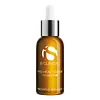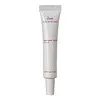What's inside
What's inside
 Key Ingredients
Key Ingredients

 Benefits
Benefits

 Concerns
Concerns

 Ingredients Side-by-side
Ingredients Side-by-side

Water
Skin ConditioningAscorbic Acid
AntioxidantLaureth-4
EmulsifyingAlcohol Denat.
AntimicrobialPentylene Glycol
Skin ConditioningPropylene Glycol
HumectantTriethanolamine
BufferingTocopherol
AntioxidantGlycerin
HumectantBioflavonoids
Skin ConditioningRetinol
Skin ConditioningOlea Europaea Leaf Extract
PerfumingZinc Sulfate
AntimicrobialPolyporus Umbellatus Extract
Skin ProtectingArbutin
AntioxidantPolysorbate 20
EmulsifyingPhenoxyethanol
PreservativeWater
Skin ConditioningCetearyl Alcohol
EmollientNiacinamide
SmoothingGlyceryl Stearate
EmollientCaprylic/Capric Triglyceride
MaskingC12-15 Alkyl Benzoate
AntimicrobialCyclopentasiloxane
EmollientDimethicone
EmollientDimethicone/Vinyl Dimethicone Crosspolymer
Skin ConditioningCeteareth-29
CleansingCetyl Palmitate
EmollientCeteareth-12
EmulsifyingCeteareth-20
CleansingPEG-100
HumectantCaffeine
Skin ConditioningPropylene Glycol
HumectantGlycerin
HumectantDimethyl Sulfone
SolventAloe Barbadensis Leaf Juice
Skin ConditioningSaccharide Isomerate
HumectantPhenoxyethanol
PreservativeSodium Hyaluronate
HumectantPotassium Cetyl Phosphate
EmulsifyingMacadamia Ternifolia Seed Oil
EmollientTrehalose
HumectantSqualane
EmollientTocopheryl Acetate
AntioxidantBisabolol
MaskingRetinyl Palmitate
Skin ConditioningCopernicia Cerifera Cera
EmollientRetinol
Skin ConditioningPropanediol
SolventBHT
AntioxidantSodium Cocoamphoacetate
CleansingXanthan Gum
EmulsifyingCaprylyl Glycol
EmollientSodium Citrate
BufferingCitric Acid
BufferingDisodium EDTA
Water, Cetearyl Alcohol, Niacinamide, Glyceryl Stearate, Caprylic/Capric Triglyceride, C12-15 Alkyl Benzoate, Cyclopentasiloxane, Dimethicone, Dimethicone/Vinyl Dimethicone Crosspolymer, Ceteareth-29, Cetyl Palmitate, Ceteareth-12, Ceteareth-20, PEG-100, Caffeine, Propylene Glycol, Glycerin, Dimethyl Sulfone, Aloe Barbadensis Leaf Juice, Saccharide Isomerate, Phenoxyethanol, Sodium Hyaluronate, Potassium Cetyl Phosphate, Macadamia Ternifolia Seed Oil, Trehalose, Squalane, Tocopheryl Acetate, Bisabolol, Retinyl Palmitate, Copernicia Cerifera Cera, Retinol, Propanediol, BHT, Sodium Cocoamphoacetate, Xanthan Gum, Caprylyl Glycol, Sodium Citrate, Citric Acid, Disodium EDTA
Ingredients Explained
These ingredients are found in both products.
Ingredients higher up in an ingredient list are typically present in a larger amount.
Glycerin is already naturally found in your skin. It helps moisturize and protect your skin.
A study from 2016 found glycerin to be more effective as a humectant than AHAs and hyaluronic acid.
As a humectant, it helps the skin stay hydrated by pulling moisture to your skin. The low molecular weight of glycerin allows it to pull moisture into the deeper layers of your skin.
Hydrated skin improves your skin barrier; Your skin barrier helps protect against irritants and bacteria.
Glycerin has also been found to have antimicrobial and antiviral properties. Due to these properties, glycerin is often used in wound and burn treatments.
In cosmetics, glycerin is usually derived from plants such as soybean or palm. However, it can also be sourced from animals, such as tallow or animal fat.
This ingredient is organic, colorless, odorless, and non-toxic.
Glycerin is the name for this ingredient in American English. British English uses Glycerol/Glycerine.
Learn more about GlycerinPhenoxyethanol is a preservative that has germicide, antimicrobial, and aromatic properties. Studies show that phenoxyethanol can prevent microbial growth. By itself, it has a scent that is similar to that of a rose.
It's often used in formulations along with Caprylyl Glycol to preserve the shelf life of products.
Propylene Glycol is an odorless, colorless liquid. As a humectant, it helps skin retain moisture. It also aids in delivering active ingredients.
Another role of this ingredient is preventing a product from melting or freezing. Propylene glycol also adds antimicrobrial properties to a product, elongating product lifespan.
This ingredient is considered an organic alcohol and commonly added into both cosmetics and foods.
Those with sensitive skin or conditions may develop a rash when using this ingredient.
Learn more about Propylene GlycolRetinol is a gold-standard ingredient for anti-aging. It is a form of Vitamin A and belongs to the class of retinoids that also includes tretinoin.
Why is retinol famous?
It has the most scientific studies backing up its skin benefits out of all the non-prescription ingredients.
Retinol is proven to:
This is why retinol is effective at removing wrinkles, fading dark spots, treating acne, and reducing the appearance of pores.
Studies show retinol is less effective when exposed to UV. Be sure to look for appropriate packaging to keep your retinol potent (similar to Vitamin C).
Using retinol or any retinoids will increase sun-sensitivity in the first few months. Though studies show retinoids increase your skin's natural SPF with continuous use, it is best to always wear sunscreen and sun-protection.
We recommend speaking with a medical professional about using this ingredient during pregnancy.
Retinol may cause irritation in some people, so be sure to patch test. Experts recommend 'ramping up' retinol use: start using this ingredient once a week and work up to using it daily.
Read about Tretinoin
Learn more about RetinolWater. It's the most common cosmetic ingredient of all. You'll usually see it at the top of ingredient lists, meaning that it makes up the largest part of the product.
So why is it so popular? Water most often acts as a solvent - this means that it helps dissolve other ingredients into the formulation.
You'll also recognize water as that liquid we all need to stay alive. If you see this, drink a glass of water. Stay hydrated!
Learn more about Water